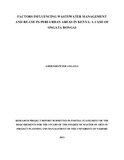| dc.description.abstract | Water related challenges are increasingly becoming recognized as a major environmental threat to mankind. Since 1950s, water use has more than tripled, according to WHO and UNICEF report of 2000, lack of access to safe drinking water affects the health of 1.2billion people annually. In order to address these challenges there is need to improve the efficiency of consumptions and seek sustainable alternative sources. Several approaches exist among them efficient and effective wastewater management and reuse to supplement fresh water and keep environment clean. This study was based in Ongata Rongai, Kajiado county Kenya. The purpose of the study was to investigate the factors that influence wastewater management and reuse in peri-urban areas in Kenya. It was guided by six objectives: to assess the influence of water
availability on wastewater management and reuse in Ongata Rongai; to assess the influence of culture on wastewater management and reuse in Ongata Rongai; to examine the influence of institutional arrangements on wastewater management and reuse; to establish the influence of developmental planning on wastewater management and reuse in Ongata Rongai; to examine the influence of financial resources on wastewater management and reuse and to assess the influence of technology on wastewater management and reuse in Ongata Rongai. This was a fact finding
study and therefore descriptive research design was employed under which survey and
observation methods were used in data collection. Cluster sampling was used in which the study area was divided into six clusters (area - cluster sampling) and simple random selection of fifty sampling units were studied in each of the clusters totaling to three hundred units. The data was manually edited, coded and analyzed using mainly descriptive statistics and inferential statistics that were done with the help of Excel and SPSS. Pearson's Correlation Coefficient and Chisquare analysis were used to establish the association and relationship between the independent and dependent variables. The study established that water availability has direct influence on
wastewater management and reuse. The Pearson's Correlation Coefficient between the
respective indicators and wastewater reuse were very close to one signifying a statistically
significant correlation. Similar results were found between the following variables and
wastewater management and reuse in Ongata Rongai: financial resources, developmental
planning and technology. Chi square analysis between culture, institutional arrangement and waste water management and reuse yielded results that showed insignificant association between them and wastewater management and reuse in Ongata Rongai. Among the recommendations made by the study are legislations of enforceable by-laws governing reuse of wastewater, educational awareness to equip people with the advantages of reusing wastewater to for example conserve the environment and reduce water stress on fresh water. Further research is required to establish the influence of education, political commitment, age, attitude, poverty, health and
safety among others on wastewater management and reuse. | en_US |

